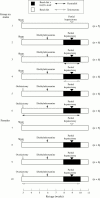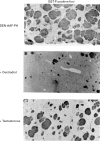Suppressive effect of oestradiol on chemical hepatocarcinogenesis in rats
- PMID: 9505896
- PMCID: PMC1726966
- DOI: 10.1136/gut.42.1.112
Suppressive effect of oestradiol on chemical hepatocarcinogenesis in rats
Abstract
Aims: To examine the effects of oestradiol and testosterone on the early carcinogenic changes expressed in rat liver from the diethylnitrosamine (DEN), 2-acetylaminofluorene (AAF), partial hepatectomy (PH) model of hepatocarcinogenesis.
Methods: Preneoplastic liver lesions were evaluated using immunohistochemical analysis of glutathione-S-transferase placental form (GST-P) expression; oestrogen and androgen receptor levels were measured by radioimmunoassay.
Results: Oestradiol administration to non-castrated DEN-AAF-PH treated males resulted in a decrease in the area of GST-P positive foci, while testosterone increased the serum oestradiol level and reduced the area. In males, castration alone and castration with oestradiol replacement significantly reduced the GST-P positive area, and increased the hepatic oestrogen receptor level. In DEN-AAF-PH treated females, castration with testosterone replacement was associated with a significant increase in the GST-P positive area and the hepatic androgen receptor level.
Conclusion: These findings suggest that exogenous and endogenous oestradiol can suppress chemical hepatocarcinogenesis. It appears that oestrogen receptors may be involved in the inhibition of malignant transformation of preneoplastic liver cells, while androgens and androgen receptors are involved in hepatocarcinogenesis.
Figures





Similar articles
-
Suppressive effect of herbal compound 861 on chemical hepatocarcinogenesis in rats.Chin Med J (Engl). 2003 Mar;116(3):378-82. Chin Med J (Engl). 2003. PMID: 12781041
-
Role of diethylnitrosamine, 2-acetylaminofluorene and partial hepatectomy in the expression of glutathione-S-transferase-P and gamma-glutamyltranspeptidase in the early steps of rat liver carcinogenesis.Tumour Biol. 1992;13(3):152-61. doi: 10.1159/000217759. Tumour Biol. 1992. PMID: 1352647
-
[Effects of sex hormones on the expression of placenta form glutathione S-transferase (GST-P) in rat induced hepatocarcinoma].Shi Yan Sheng Wu Xue Bao. 1998 Dec;31(4):393-401. Shi Yan Sheng Wu Xue Bao. 1998. PMID: 12016962 Chinese.
-
Age-dependent induction of preneoplastic liver cell foci by 2-acetylaminofluorene, phenobarbital and acetaminophen in F344 rats initially treated with diethylnitrosamine.Jpn J Cancer Res. 1991 Mar;82(3):293-7. doi: 10.1111/j.1349-7006.1991.tb01845.x. Jpn J Cancer Res. 1991. PMID: 1902451 Free PMC article.
-
Specific expression of glutathione S-transferase Pi forms in (pre)neoplastic tissues: their properties and functions.Tohoku J Exp Med. 1992 Oct;168(2):97-103. doi: 10.1620/tjem.168.97. Tohoku J Exp Med. 1992. PMID: 1306337 Review.
Cited by
-
Hepatocyte-specific HDAC3 ablation promotes hepatocellular carcinoma in females by suppressing Foxa1/2.BMC Cancer. 2023 Sep 26;23(1):906. doi: 10.1186/s12885-023-11393-1. BMC Cancer. 2023. PMID: 37752418 Free PMC article.
-
Age-dependent sensitivity of Big Blue transgenic mice to the mutagenicity of N-ethyl-N-nitrosourea (ENU) in liver.Mutat Res. 2005 May 2;572(1-2):14-26. doi: 10.1016/j.mrfmmm.2004.11.011. Mutat Res. 2005. PMID: 15790487 Free PMC article.
-
Epidemiological characteristics of suspected adenomyosis in the Chinese physical examination population: a nested case-control study.BMJ Open. 2024 Jan 12;14(1):e074488. doi: 10.1136/bmjopen-2023-074488. BMJ Open. 2024. PMID: 38216177 Free PMC article.
-
Apoptotic and anti-proliferative effects of 17beta-estradiol and 17beta-estradiol-like compounds in the Hep3B cell line.Mol Cell Biochem. 2006 Oct;290(1-2):1-7. doi: 10.1007/s11010-005-9000-y. Epub 2006 Aug 19. Mol Cell Biochem. 2006. PMID: 16924424
-
Female hepatology: favorable role of estrogen in chronic liver disease with hepatitis B virus infection.World J Gastroenterol. 2007 Aug 28;13(32):4295-305. doi: 10.3748/wjg.v13.i32.4295. World J Gastroenterol. 2007. PMID: 17708600 Free PMC article. Review.
References
Publication types
MeSH terms
Substances
LinkOut - more resources
Full Text Sources
Molecular Biology Databases
Research Materials
